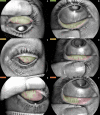Oral isotretinoin for acne vulgaris side effects on the ocular surface: Hyaluronic acid and galacto-xyloglucan as treatment for dry eye disease signs and symptoms
- PMID: 35935781
- PMCID: PMC9353322
- DOI: 10.3389/fmed.2022.959165
Oral isotretinoin for acne vulgaris side effects on the ocular surface: Hyaluronic acid and galacto-xyloglucan as treatment for dry eye disease signs and symptoms
Abstract
The purpose was to assess the efficacy of 0.4% hyaluronic acid and 0.2% galacto-xyloglucan on the subjective symptoms of dry eye disease and invasive and non-invasive tear film signs in oral isotretinoin for acne vulgaris treatment. A prospective, longitudinal, single-blind, clinical study was performed in oral isotretinoin for the acne vulgaris consumer population. Subjective dry eye disease questionnaires and invasive and non-invasive tear film assessments were reported prior to and after 6 weeks of hyaluronic acid with galacto-xyloglucan (HA-GX) treatment vs. hyaluronic acid alone (HA). Participants in the HA-GX group reported a higher decrease in the ocular surface disease index (17.01 ± 11.36 score points) compared to the variation in participants in the HA group (11.61 ± 11.18 score points). Standard patient evaluation of eye dryness also decreased more in participants in the HA-GX group (4.06 ± 5.50 score points) than in participants who received HA alone (0.70 ± 3.16). Regarding non-invasive break-up time (NIBUT), participants in the HA-GX group first NIBUT achieved an increase of 1.75 ± 1.16 s while participants in the HA-alone group demonstrated an increase of only 0.54 ± 1.01 s. The HA-GX group mean NIBUT increased by of 3.72 ± 5.69 s; however, the value for the HA-alone group was 2.19 ± 5.26 s. Hyaluronic acid in combination with galacto-xyloglucan significantly decreased limbal and bulbar conjunctival redness classification and SPEED test outcomes. The inclusion of galacto-xyloglucan also increased BUT and mean NIBUT values compared to those obtained with hyaluronic acid alone.
Keywords: acne vulgaris; dry eye disease; eyedrops; galacto xyloglucan; hyaluronic acid; isotretinoin; tear film.
Copyright © 2022 Sánchez-González, De-Hita-Cantalejo, Martínez-Lara and Sánchez-González.
Conflict of interest statement
The authors declare that the research was conducted in the absence of any commercial or financial relationships that could be construed as a potential conflict of interest.
Figures


Similar articles
-
Hyaluronic Acid and Galacto-Xyloglucan Eyedrop Efficacy in Young-Adult Oral Contraceptive Users of Childbearing Age.J Clin Med. 2022 Jul 30;11(15):4458. doi: 10.3390/jcm11154458. J Clin Med. 2022. PMID: 35956073 Free PMC article.
-
Comparison of efficacy of trehalose-based eye drops versus topical 0.1% Hyaluronic Acid for management of clinically significant dry eye using non-invasive investigational modalities.Int Ophthalmol. 2021 Oct;41(10):3349-3359. doi: 10.1007/s10792-021-01897-9. Epub 2021 May 27. Int Ophthalmol. 2021. PMID: 34043117 Clinical Trial.
-
Tear Film Stabilization and Symptom Improvement in Dry Eye Disease: The Role of Hyaluronic Acid and Trehalose Eyedrops versus Carmellose Sodium.J Clin Med. 2023 Oct 20;12(20):6647. doi: 10.3390/jcm12206647. J Clin Med. 2023. PMID: 37892784 Free PMC article.
-
Ocular manifestations of systemic isotretinoin in patients with acne: a systemic review and meta-analysis.Cutan Ocul Toxicol. 2022 Jun;41(2):113-122. doi: 10.1080/15569527.2022.2050747. Epub 2022 Mar 16. Cutan Ocul Toxicol. 2022. PMID: 35296199
-
A Meta-Analysis of the Efficacy of Hyaluronic Acid Eye Drops for the Treatment of Dry Eye Syndrome.Int J Environ Res Public Health. 2021 Mar 1;18(5):2383. doi: 10.3390/ijerph18052383. Int J Environ Res Public Health. 2021. PMID: 33804439 Free PMC article. Review.
Cited by
-
Tear film layers and meibomian gland assessment in patients with type 1 diabetes mellitus using a noninvasive ocular surface analyzer: a cross-sectional case-control study.Graefes Arch Clin Exp Ophthalmol. 2023 May;261(5):1483-1492. doi: 10.1007/s00417-022-05934-w. Epub 2022 Dec 13. Graefes Arch Clin Exp Ophthalmol. 2023. PMID: 36512089 Free PMC article.
-
Untargeted Lipidomics Analysis to Discover Lipid Profiles and Biomarkers of Rabbit Acne Model and Reveal Action Mechanism of Isotretinoin.Drug Des Devel Ther. 2024 Sep 6;18:4003-4016. doi: 10.2147/DDDT.S476649. eCollection 2024. Drug Des Devel Ther. 2024. PMID: 39258275 Free PMC article.
-
Physiological and Psychological Effects of Isotretinoin in the Treatment of Patients with Acne: A Narrative Review.Clin Cosmet Investig Dermatol. 2023 Jul 18;16:1843-1854. doi: 10.2147/CCID.S416267. eCollection 2023. Clin Cosmet Investig Dermatol. 2023. PMID: 37483471 Free PMC article. Review.
-
Exploring the Cutting Edge of Vision Science: New Developments in Diagnostics and Treatment of Ocular Surface in Dry Eye Disease.Life (Basel). 2023 Jul 19;13(7):1584. doi: 10.3390/life13071584. Life (Basel). 2023. PMID: 37511959 Free PMC article.

